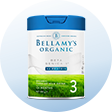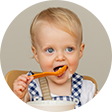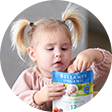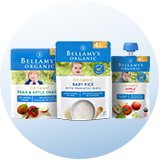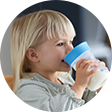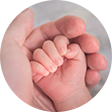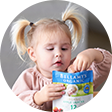Iron-Rich Foods for Toddlers: Five of the Best
Iron is an essential mineral found in the blood and is responsible for transporting oxygen around the body. For toddlers, iron is necessary for optimal growth, development, cognition, motor development and plays a vital role in immunity. The requirement for iron in toddlers is high because of their rapid rate of growth. Iron deficiency is the most common nutritional deficiency in children worldwide.1 It can be easy for toddlers to fall short of their needs if their diet isn't carefully planned.
Signs of Iron Deficiency in Children: 1
While the cause of iron deficiency in children can be complexed and varied it is important to know the signs to look out for. These are the most common symptoms of iron-deficiency:
- Repeat infections
- Pale complexion
- Red eyes
- Loss of appetite
- Behavioural problems, especially with an inability to concentrate and maintain focus on a task
- Breathlessness
- Increased sweating
- Pica (strange food cravings for things like ice, plastic toys, eating dirt, etc.)
- Slow growth and development
Children Particularly at Risk of Iron Deficiency:
Children are typically at higher risk for iron deficiency because of their greater need for iron. Some of the major risk factors for the development of iron deficiency in children include:
- Infants with delayed introduction of solids beyond six months
- Prematurity or low birth weight
- Children who do not regularly consume haem iron sources (3-4x per week), or only consume in minimal amounts
- Picky/fussy eaters who have poor variety in their diets
- Vegetarian or vegan children, if their food intake isn't carefully planned 2
Understanding the difference between haem vs non-haem iron
There are two types of iron found in the diet:
- Haem iron is found in animal foods and is well absorbed by the body.
- Non-haem Iron is found in plant foods which is less bioavailable.
Children should be encouraged to eat a wide variety of iron-rich foods every day to ensure they are meeting their daily requirements to support growth and development. The National Health and Medical Research Council (NHMRC) recommended the daily intake (RDI) for 1-3 years old's is 9mg/day, and 4-8-year old's is 10 mg/day.3
Five of the best iron-rich foods for toddlers
Haem Sources
1. Red Meat (preferably organic)
Ground beef used to make Bolognese sauce or meatballs and frenched lamb cutlets are all great finger food options for toddlers. Cheesy Cutlets, Kid’s Bolognese and Beef Stew are all infant-friendly meal options that offer plenty of well-absorbed iron. Iron per serving: 100g beef=3.5g or 100g lamb= 2.5g 4
2. Darker Poultry Meats (preferably organic)
Chicken liver is one of the densest animal sources of iron. Spreading organic chicken liver on toast or crackers makes a great snack for toddlers. Alternatively, you can add a small amount of chopped liver to stews. Chicken and turkey thighs or legs are also a great source of iron and contain much more than the breast meat. Iron per serving: 100g chicken liver = 11mg or 100g chicken thigh= 1.3mg 4
Non-Haem Sources
3. Eggs (preferably organic)
Eggs, in particular, the yolk, are a reasonably good source of iron. Make scrambled eggs, frittata, or add them to baking. A boiled egg also makes a great on the go snack for toddlers. You can incorporate eggs into recipes like Egg & Avocado Dippers, Veggie Patties, Baked Eggs, Mini Egg Bites and Omelettes. Iron per serving: 1 whole eggs = 0.6mg
4. Green Lentils
Lentils are not only a great source of iron but also count as a serving of vegetables. Try making lentil patties or adding to soups or stews. Iron per serving: 1⁄2 cup green lentils= 1.5mg 4
5. Iron Fortified Cereals
Fortified cereals, like Bellamy's Baby Porridge, is a great way to add extra iron to your toddlers’ diet. Serve as a porridge with chopped fruit or replace some flour for a few tablespoons when making homemade muffins. You can also try making these Healthy Oat Cookies for a iron-rich snack. Iron per serving: 14g (1 tablespoon) = 3.2mg
How to increase the absorption of iron
In addition to offering iron-rich foods, you can also increase absorption by adding iron enhancers, while avoiding inhibitors with meals.
Iron enhancers
Vitamin C Rich Foods Consuming vitamin C rich foods together with foods rich in non-haem iron may increase iron absorption by up to 300 times. Add a squeeze of lemon juice, handful of berries or a serve of citrus fruits to iron-rich meals.
Foods rich in amino acid lysine
The amino acid lysine is essential for iron absorption. Red meat, poultry, and eggs are all excellent sources of lysine naturally. Plant sources of lysine include avocado, tomatoes, most beans and legumes, and quinoa.
Avoiding iron inhibitors
Phytic Acid
Phytic acid found in whole grains can inhibit the absorption of iron. If iron deficiency is a problem for your toddler, swapping whole grains for refined grains (e.g. Wholemeal sourdough bread for white sourdough bread) temporarily can help improve iron absorption. Phytic acid can also be found in legumes and beans, even though they are a great source of iron. Always soak legumes and beans before cooking to reduce their phytic acid content.
Whole Cow’s Milk
Due to its high calcium content, cow’s milk can reduce the absorption of iron.5 Toddlers require no more than 1 1⁄2 serves of milk, yoghurt, cheese, or calcium-rich alternatives daily. A standard serve is equal to 1 cup of milk, 1⁄2 cup ricotta, 3⁄4 cup yoghurt, and/or two slices of cheese. 6 It's important to note that regular cow's milk is a poor source of iron, while toddler milk is fortified with iron. An Australian based cohort study SMILE 7 found that toddler milk served as a significant dietary source of iron for this age group, providing over half the RDI for those who consumed it. Iron per serving: Bellamy’s Toddler Milk 100ml = 1.2mg and Pasteurized Regular Cow’s Milk = 0mg
Choosing iron-rich foods from Bellamy’s Organic
Ensuring your toddler is getting enough iron each day can be a real juggling act, particularly if they have a smaller appetite or are prone to fussy eating. Focusing on including an iron-rich food with at least 2 main meals daily, as well as adding an iron enhancer and limiting inhibitors need be. Iron-fortified foods, such as Bellamy's Baby Porridges and Toddler Milk can be of benefit during this period of rapid growth.
References
1. Jacquelyn M Powers, MD, MSDonald H Mahoney, Jr, MD. Iron deficiency in infants and children <12 years: Screening, prevention, clinical manifestations, and diagnosis. https://www.uptodate.com/contents/iron-deficiency-in-infants-and-children-less-than12-years-screening-prevention-clinical-manifestations-and-diagnosis (2020).
2. Baroni, L. et al. Vegan Nutrition for Mothers and Children: Practical Tools for Healthcare Providers. Nutrients 11, 5 (2018).
3. National Health and Medical Research Council. Nutrient Reference Values for Australia and New Zealand. (Commonwealth of Australia, 2008).
4. Iron Fact Sheet. (2014).
5. Wright, C. M., Parkinson, K. N., Shipton, D. & Drewett, R. F. How Do Toddler Eating Problems Relate to Their Eating Behavior, Food Preferences, and Growth? PEDIATRICS 120, e1069–e1075 (2007).
6. Eat For Health: Australian Dietary Guidelines. (2013).
7. Scott, J. A., Gee, G., Devenish, G., Ha, D. & Do, L. Determinants and Sources of Iron Intakes of Australian Toddlers: Findings from the SMILE Cohort Study. Int. J. Environ. Res. Public. Health 16, 181 (2019).










